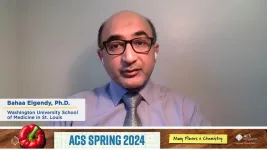(Press-News.org) Researchers at Weill Cornell Medicine have performed the most comprehensive analysis to date of cancer of the ureters or the urine-collection cavities in the kidney, known as upper tract urothelial carcinoma (UTUC). The study, which compared the characteristics of primary and metastatic tumors, provides new insights into the biology of these aggressive cancers and potential ways to treat them.
In the study, which appeared March 18 in Nature Communications, the researchers examined tissue samples from 44 primary and metastatic UTUC tumors. They compared gene mutations and gene activity patterns in these tumors and mapped cell types using a technology that can visualize protein surface markers at the single-cell resolution. A key finding was that the basic molecular characteristics of these UTUC tumors—their molecular subtype—are mostly stable during the evolution from the primary to the metastatic stage. That suggests that oncologists treating UTUC patients may often be able to use analyses of primary tumor samples for molecular subtype-guided treatment of metastases.
“This dataset we generated provides unique insights into UTUC biology and should be an important resource for researchers and clinicians,” said Dr. Juan Miguel Mosquera, a professor of pathology and laboratory medicine and director of research pathology in the Englander Institute for Precision Medicine at Weill Cornell Medicine.
Dr. Mosquera, who is also a member of the Sandra and Edward Meyer Cancer Center at Weill Cornell Medicine, co-led the study with Dr. Bishoy Faltas, an assistant professor of medicine and the Gellert Family-John P. Leonard, M.D. Research Scholar at Weill Cornell Medicine. The study’s first author is Dr. Kentaro O’Hara, who was a postdoctoral research fellow in the Department of Pathology and Laboratory Medicine and in the Englander Institute for Precision Medicine when the study was conducted.
UTUC tumors are rare compared to bladder tumors, accounting for 5 to 10 percent of all urothelial cancers. They are also considered relatively aggressive, and metastatic UTUC tumors are particularly hard to treat successfully. Previously, Dr. Faltas and colleagues illuminated the molecular details of primary UTUC tumors in a widely cited 2019 study. Much less has been known about the characteristics of metastatic tumors that have already spread to distant organs.
Building on this work, the researchers used DNA and RNA sequencing in the current study to map the gene mutations and gene activity patterns in the primary and metastatic samples. With funding from the Cornell Center for Immunology, they also employed a newer technique called Imaging Mass Cytometry. This technique labels key surface proteins on individual cells in the samples, enabling detailed, cell-by-cell identification and spatial mapping of cell types.
“The Imaging Mass Cytometry allowed us for the first time to explore the spatial relationships between tumor cells and other cells such as immune cells that make up the UTUC tumor microenvironment,” said Dr. Mosquera, who is also a pathologist at NewYork-Presbyterian/Weill Cornell Medical Center.
The 2019 study led by Dr. Faltas revealed that primary UTUC tumors usually belong to a particular molecular subtype that also features a relative absence of T cells—suggesting immune suppression in the tumor microenvironment. The new analysis confirmed this pattern and found that metastatic UTUC tumors in a given patient tended to have the same characteristics as the primary tumor.
“Frequently, we are unable to obtain sufficient biopsy tissue from metastatic tumors and have to rely on the molecular analysis of the primary tumor, so it’s important to know that the molecular subtype based on RNA expression is generally stable from the primary to the metastatic stages,” said Dr. Faltas, who is also director of bladder cancer research in the Englander Institute for Precision Medicine and a member of the Meyer Cancer Center at Weill Cornell Medicine, and an oncologist at NewYork-Presbyterian/Weill Cornell Medical Center. “We were able to understand the contributions of different cell types to these molecular subtypes and how they evolve over the cancer’s natural history by analyzing the protein expression of hundreds of thousands of single cells from these tumors.”
The researchers also observed that metastatic UTUC tumor cells had genetic mutations not found in the primary tumors. These differences were much greater in patients undergoing chemotherapy, suggesting that chemotherapy may have induced some mutations.
The study sets the stage for highly personalized, molecularly-guided primary and metastatic UTUC treatment strategies to improve patient outcomes. The single-cell insights gained have the potential to accelerate the development of targeted therapies and immunomodulatory approaches and transform the landscape of UTUC management.
Research reported in this story was supported by the National Cancer Institute of the National Institutes of Health under award number T32CA203702. The research was also supported by funding from the Starr Cancer Consortium.
Many Weill Cornell Medicine physicians and scientists maintain relationships and collaborate with external organizations to foster scientific innovation and provide expert guidance. The institution makes these disclosures public to ensure transparency. For this information, see profile for Dr. Juan Miguel Mosquera and Dr. Bishoy Faltas.
END
Mapping the evolution of urinary tract cancer cells
2024-03-18
ELSE PRESS RELEASES FROM THIS DATE:
Implantable sensor could lead to timelier Crohn’s treatment
2024-03-18
· Temperature sensor warns of disease flareups, tracks disease progression in real time
· Currently no way to quickly detect inflammation, leading to invasive surgeries
· Strategy could be useful in ulcerative colitis, another inflammatory bowel disease
CHICAGO --- A team of Northwestern University scientists has developed the first wireless, implantable temperature sensor to detect inflammatory flareups in patients with Crohn’s disease. The approach offers long-term, real-time monitoring and ...
Glucose levels affect cognitive performance in people with type 1 diabetes differently
2024-03-18
A new study led by researchers at McLean Hospital (a member of Mass General Brigham) and Washington State University used advances in digital testing to demonstrate that naturally occurring glucose fluctuations impact cognitive function in people with Type 1 Diabetes (T1D). Results showed that cognition was slower in moments when glucose was atypical – that is, considerably higher or lower than someone’s usual glucose level. However, some people were more susceptible to the cognitive effects of large glucose fluctuations than others.
“In trying to understand how diabetes impacts the brain, our research shows that it is important to consider not only how people ...
Mimicking exercise with a pill
2024-03-18
NEW ORLEANS, March 18, 2024 — Doctors have long prescribed exercise to improve and protect health. In the future, a pill may offer some of the same benefits as exercise. Now, researchers report on new compounds that appear capable of mimicking the physical boost of working out — at least within rodent cells. This discovery could lead to a new way to treat muscle atrophy and other medical conditions in people, including heart failure and neurodegenerative disease.
The researchers will present their ...
New composite decking could reduce global warming effects of building materials
2024-03-18
NEW ORLEANS, March 18, 2024 — Buildings and production of the materials used in their construction emit a lot of carbon dioxide (CO2), a potent greenhouse gas that contributes to global warming and climate change. But storing CO2 in building materials could help make them more environmentally friendly. Scientists report that they have designed a composite decking material that stores more CO2 than is required to manufacture it, providing a “carbon-negative” option that meets building codes and is less expensive than standard composite decking.
The researchers will present their results today at the spring meeting of the American Chemical Society ...
Artificial mucus identifies link to tumor formation
2024-03-18
NEW ORLEANS, March 18, 2024 – During cold and flu season, excess mucus is a common, unpleasant symptom of illness, but the slippery substance is essential to human health. To better understand its many roles, researchers synthesized the major component of mucus, the sugar-coated proteins called mucins, and discovered that changing the mucins of healthy cells to resemble those of cancer cells made healthy cells act more cancer-like.
The researcher will present her results today at the spring meeting of the American Chemical Society (ACS). ACS Spring 2024 is a hybrid meeting being held virtually and in person March 17-21; it features nearly 12,000 ...
Study explores homeless women’s experiences of ‘period poverty’
2024-03-18
Research from the University of Southampton has identified common issues women face when experiencing periods while homeless.
A review of research published in Women and Health has found homeless women experienced practical challenges in managing menstruation alongside feelings of embarrassment and shame, with many ‘making do’ due to inadequate provision.
The researchers say it’s high time to address the provision of menstrual health resources as a basic human right.
Dr Stephanie Barker, a teaching fellow at the University of ...
Keeping score: novel method might help differentiate 2 serious skin diseases
2024-03-18
Your skin becomes red and spots filled with pus appear, so you visit a dermatologist. When these symptoms spread to the skin throughout the body, it is difficult for the physician to distinguish whether it is generalized pustular psoriasis (GPP) or acute generalized exanthematous pustulosis (AGEP), as both have similar symptoms. The two diseases run different courses and require different treatments. Without proper treatment, the symptoms can worsen severely and cause complications, so it is essential to distinguish between them.
Researchers ...
Developing bifunctional catalyst performance enhancement technology that will dramatically lower the cost of hydrogen production
2024-03-18
Dr. Hyung-Suk Oh and Dr. Woong-Hee Lee of the Clean Energy Research Center at the Korea Institute of Science and Technology (KIST), in collaboration with POSTECH and Yonsei University, have developed a methodology to improve the reversibility and durability of electrodes using bifunctional platinum-nickel alloy catalysts with an octahedral structure that exhibits both oxygen reduction and generation reactions.
Bifunctional catalysts are a new generation of catalysts that simultaneously produce hydrogen and oxygen from water using a single catalyst. Currently, electrochemical systems such as water electrolysis technology and CCU (carbon dioxide ...
Animal hair structure changes from summer to winter to fend off freezing weather
2024-03-17
NEW ORLEANS, March 17, 2024 — Unique adaptations allow wild animals to survive temperature extremes that would quickly kill an unprotected human. For example, certain animals can withstand bitterly cold weather, thanks to the insulating properties of the hollow hairs that make up their coats. Little has been known about the hairs, but now, researchers have discovered that their inner structure changes with the seasons.
The researchers will present their results today at the spring meeting of the American Chemical Society (ACS). ACS Spring 2024 is a hybrid meeting being held virtually and in person March ...
The many flavors of edible ants
2024-03-17
NEW ORLEANS, March 17, 2024 — Insects are typically unwelcome visitors to a picnic, but they could be a flavorful, nutritious and sustainable addition to the menu. Eating insects is common in some parts of the world, and some species are even considered delicacies. Ants are one example, sometimes roasted whole for a snack or ground and used to add flavor and texture to dishes. Researchers now report the unique aroma profiles of four species of edible ants, which taste markedly different from one another.
The researchers will present their results today at the spring meeting of the American Chemical Society (ACS). ACS Spring 2024 is a hybrid meeting being held ...









